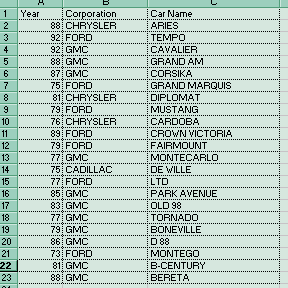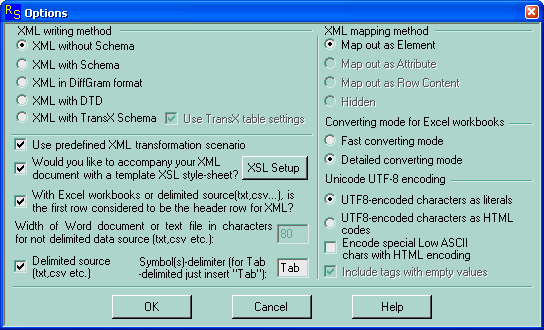  XML Converter Standard Edition
XML Converter Standard Edition
|
|
|
Most of companies around the world have a big endowment in their existing software applications. In the main, these software products work well. Although, if they can transform their data to an XML output and can admit XML for data input, then their data can be expanded and made much more flexible and useful.
MS Office formats are the most widely used data files for common business documents today, and XML is the most suitable information storage format for the future. How can them be adapted?
XML Converter is useful in a number of situations. It is the most user-friendly XML converting engine and requires less programming expertise. Also, any programming skills are not required to configure XML tags and an XSLT script to convert the raw source data into the final desired XML result.
|
|
|
It is useful software that you provide to the consumer.
It is fast, easy to use and reasonable price for purchase.
I definitely love it and will use it daily. The XML Converter has saved me a lot of time.
Thank you very much for a wonderful product.
Khoa Nguyen
IT Business Analyst
|
|
|
|
  In a nutshell about XML In a nutshell about XML
Everyone heard about XML. XML (Extensible Markup Language) is also called meta-language, which means that it can describe other languages. XML is neutral, flexible and easier to handle for data exchange.
XML is the new standard for databases and World Web, revolutionizes Internet already today. XML is NOT another HTML. The main idea of XML/XSLT is to separate a presentation and content.
XML is a best way to store and represent any data in a highly flexible and structured way.
|
|
  The XML Converter is a data converting software lets the user to interactively create a data transformation. It allows you to use XML documents by exporting
source data into XML file. XML Converter is a visual mapping and conversion tool, which manages all dialects of XML such as DTD(document type definition), XSD(XML Schema Definition), and XML formats.
It is used for quickly building application integration solutions. It will allow you to map and integrate some types of data to XML document in a user-friendly graphical mode. The XML Converter is a data converting software lets the user to interactively create a data transformation. It allows you to use XML documents by exporting
source data into XML file. XML Converter is a visual mapping and conversion tool, which manages all dialects of XML such as DTD(document type definition), XSD(XML Schema Definition), and XML formats.
It is used for quickly building application integration solutions. It will allow you to map and integrate some types of data to XML document in a user-friendly graphical mode.
|
  XML Converter quickly and easily converts source data types include the following: XML Converter quickly and easily converts source data types include the following:
ODBC data sources
Oracle tables or views
MS SQL Server tables or views
Microsoft Excel books
MySQL tables or views
Microsoft Access databases
Microsoft Word documents
Text files(csv, tab-delimited)
|

XML Converter takes care of frequent XML creation with single, easy method support for exporting data to XML. The output file is a well-formed XML from a standard template, and may come (if you need) with a standard eXtensible Style Language (XSL) sheet to render the output to HTML-view using the well-known MS Internet Explorer? and a latest version of Netscape Navigator?.
The XSL give you ability to extract, transform and render the content of an XML file. And now this specification is supported by popular of Internet browsers and you do not need a physical transformation your XML document into HTML files.
|
|
  Example Example
This demonstration highlights XML Converter technique. We need to transform the simplest MS Excel spreadsheet:
|
 |
 |
After converting to XML document we can browse a final file by using MS Internet Explorer (version 5 and later). Internet Explorer knows how to show XML in structured format.
The MS Internet Explorer can be used on the client with XML but this view is not friendly for human eyes. To adjust this view and obtain a readable XML presentation we need let the browser to transform XML file to HTML format using the rules of an XSL stylesheet.
The Extensible Style Language (XSL) is a very powerful language that allows us to specify rules that transform an XML document tree into a formatted tree we can display in the browser. Besides creating an XML document the XML Converter will allow you to generate special XSL document for this final XML file. For this case you should go to the menu bar "Options" and check the question "Would you like to accompany your XML document with a template XSL style-sheet?". Both of these files can be used for your further needs such as: web-applications, reports, presentations, and so on.
|
|
In the toolbar on main form, click 'Open' button. Choose an object from the ?Select Data Source? dialog box and press Open.
The XML Converter allows you choose the raw data storage format from either the ODBC DSN, MS Access database, MS Word document, text file, Excel Book, or Oracle table structure.
In the toolbar on main form, click 'Save' button. Choose where you would like to save your destination file.
The XML Converter allows you to browse source data and make analysis of data source structure. This software has database navigation
features that provide the ability to view your entire source file. The XML Converter allows users to see source files that they are
opening for converting. Also after converting you can review and edit destination XML document. XML Converter includes XML View, XML Tree, XML Grid, and XML Script modes for XML output editing.
|
|
  Options menu bar Options menu bar
|

|
|
On the "Options" menu bar you can adjust your XML transformation by selecting some particular types of the "XML writing methods" and "XML mapping methods".
|
|
  XML writing method XML writing method
|
|
XML writing method specifies how the XML output file is to be written.
|
|
Writing method
|
Description
|
|
XML without Schema
|
Store the Source data as XML data, without an XSD schema. This is the default.
|
|
XML with Schema
|
Store the Source data as XML data with the relational structure as inline XSD schema.
|
|
XML in DiffGram format
|
Store the whole Source data as a DiffGram, including original and current values.
The DiffGram is a format intended for network data exchange and .NET remoting.
|
|
XML with DTD
|
Store the Source data as XML data with the DTD specification.
|
|
XML with TransX Schema
|
Store the Source data as an XML data with the TransX Schema.
The Oracle TransX Utility could use your final XML file to populate an Oracle database.
|
|
|
|
  XML mapping method XML mapping method
|
|
The Mapping method determines how each Source data column is mapped when a XML document is saved.
|
|
Mapping method
|
Description
|
|
Map out as Element
|
By using this mapping method the Source data columns are written as XML elements
where the ColName is the name of the element and the contents of the column are
written as the text of the element. For example, if Mapping method is set to "Map
out as Element", the column value will produce the following XML:
<ColName>Column Contents</ColName>
This is the default.
|
|
Map out as Attribute
|
Due to this mapping method the Source data columns are written as XML attributes
of the XML document elements for the current row where the ColName is the name of
the attribute and the contents of the Source data column are written as the value
of the attribute. For example, using the "Map out as Attribute" method the
following XML is produced:
<RowElement ColName="Column Contents" />
|
|
Map out as Row Content
|
This method allows us to write contents of the Source data columns as text in the
XML elements for the current row. Example:
<RowElement>Column Contents</RowElement>
You should know that "Map out as Row Content" method cannot be set for Source data
columns of a table that has Element columns (more than one column) or nested relations.
|
|
Hidden
|
The Source data columns will not be written in the XML document.
|
 |
  XML Converter two editions XML Converter two editions |
Two editions of XML Converter are available: a Standard Edition and a Professional Edition.
The Standard Edition is an economical solution for users who need to view the Data Source and Target XML document
in order to better understand how to built a best XML representation. With the Standard Edition, users can browse
the Data Source and Target XML file to generate XML output easily using a graphical user interface, without adding
costly instrumentation.
|
XML Converter Professional Edition is a complete solution for the developer who wants the browse facilities provided in the
Standard Edition PLUS special modules, which provide command-line interface. Using the Professional Edition you will
be able to call XML Converter strictly from your own application, with no user interface, allowing you to convert Data Source to
XML in batch mode.
|
|
|



